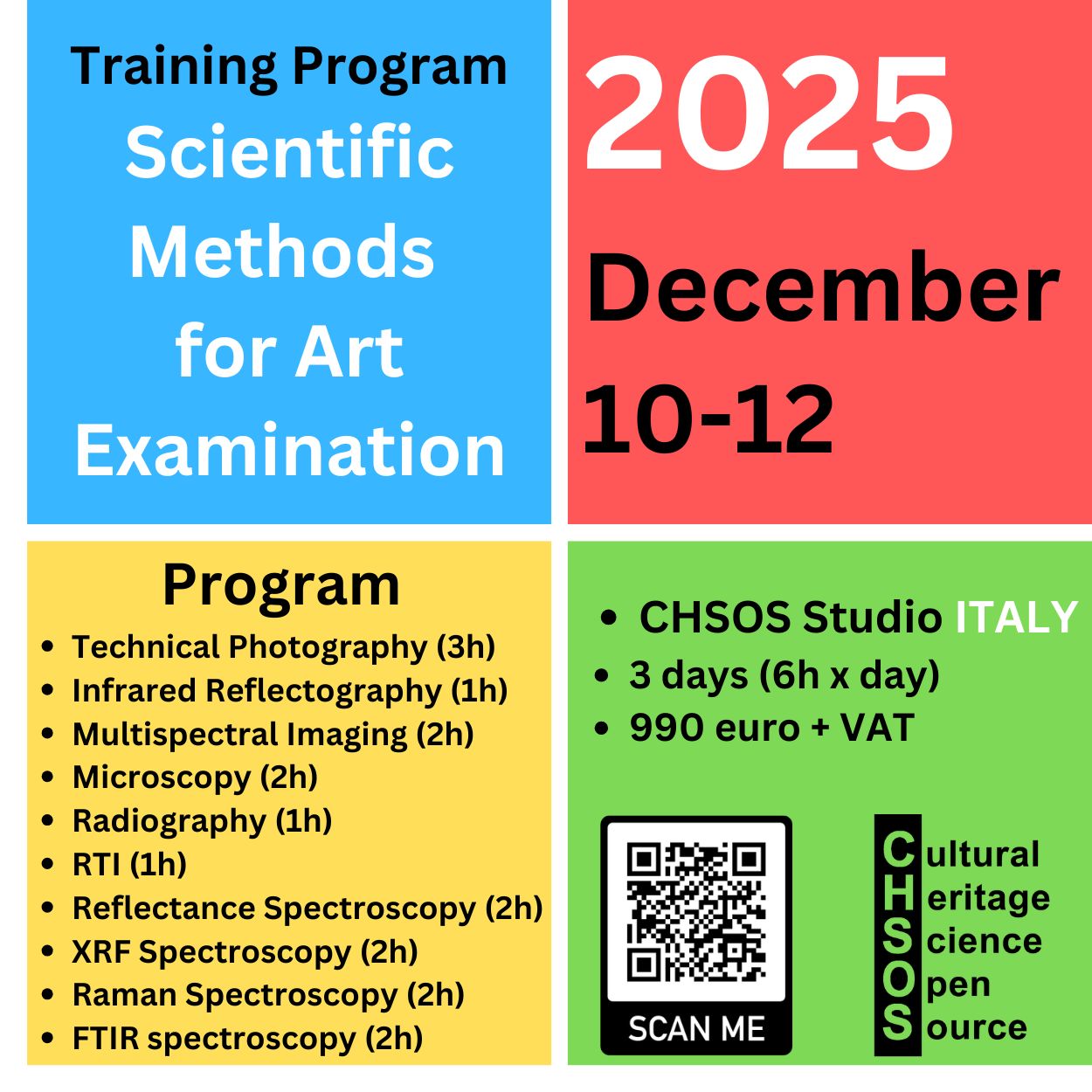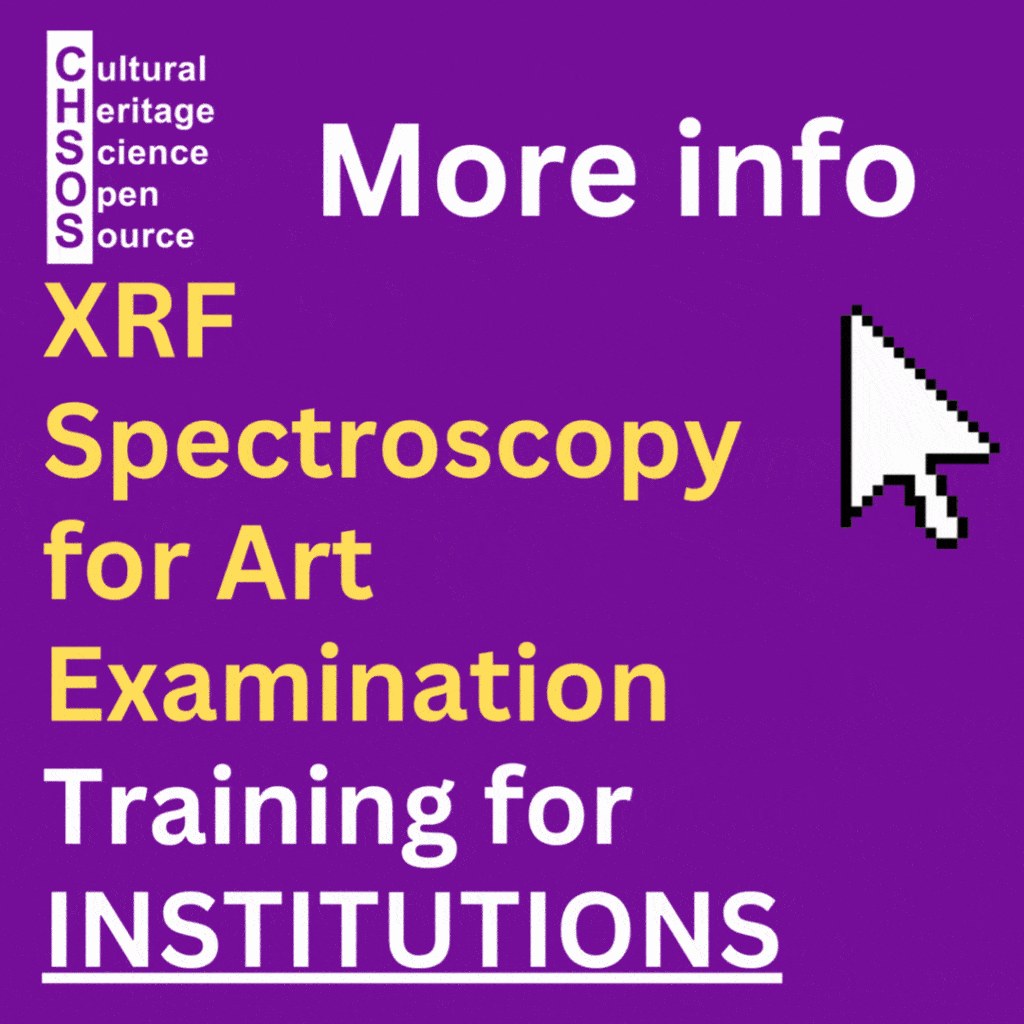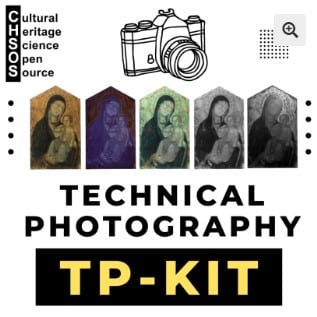Home » About » CHSOS Application Notes » CHSOS Application note #4: Reflectance Spectra Database for Pigments Checker “Modern & Contemporary Art”
Reflectance Spectroscopy in Art Examination
Just published on our website the Reflectance Spectra Database for the new Pigments Checker “Modern & Contemporary Art”. This note presents selected spectra and highlights key findings relevant to the use of reflectance spectroscopy in art examination.
Since the late ’80s [1], researchers have used Reflectance Spectroscopy (RS) in art examination as a powerful tool to identify pigments and dyes [2]. A reflectance spectrum displays, for each wavelength, the ratio between the intensity of the reflected and incident radiation. This ratio, called reflectance, is expressed as a percentage (%). To identify pigments, analysts compare the spectral features of the unknown spectrum with those in a spectral database.
This method offers several advantages over other spectroscopic techniques: affordable equipment, compact size, and high portability.
Pigments Checker “Modern & Contemporary Art”
This collection features the most important pigments used in modern and contemporary art. In contrast, the STANDARD Pigments Checker includes the most commonly used pigments from prehistory to contemporary times and, as a result, contains only a few modern pigments. This new checker focuses exclusively on modern pigments and complements those already present in the standard Pigments Checker. We applied the colors using an acrylic binder on a cardboard support. We also collected the spectra of both the individual pigments and the binder alone on the cardboard. You can find all these spectra online on the Pigments Checker webpage.
Pigments with noticeable reflectance spectroscopy features
Figure [1] shows the Gorgias system acquiring spectra on the new Pigments Checker. Several pigments display distinct and characteristic spectral features. Figure [2] presents the spectra of four modern pigments.
-
PBr 24 – Chrome titanate, introduced in 1946, shows a strong and broad absorption band centered at 730 nm.
-
PG 36 – Phthalo green YS offers excellent lightfastness. Manufacturers always combine it with extenders and fillers to improve workability. This brominated and chlorinated copper phthalocyanine exhibits a distinctive maximum near the UV region at 410 nm.
-
PY 53 – Nickel-titanium yellow serves as a modern replacement for the historical Naples yellow. This nickel antimony titanium rutile pigment displays a broad and intense absorption band centered at 740 nm.
-
PY 150 – Nickel azo yellow, a monoazo nickel complex, replaces the original Indian yellow due to its similar brownish hue. Its spectrum reveals three distinctive maxima at 600 nm, 650 nm, and 715 nm.


Titanium white, rutile, or anatase?
Titanium white refers to a white pigment composed of one or both forms of titanium dioxide: anatase and rutile. Although these two polymorphs share the same chemical formula (TiO₂), they differ in the atomic arrangement of their constituent atoms.
Currently, the standard Pigments Checker v.5 includes the rutile form of titanium white. Today, manufacturers produce all titanium white using rutile. However, this was not always the case. Initially, around 1920, producers primarily used anatase because it was easier to manufacture. Later, in the 1940s, a more affordable production method for rutile became available. As a result, rutile replaced anatase due to its superior lightfastness and stronger hiding power.
To address this historical shift, the new “modern and contemporary art” Pigments Checker includes the anatase form of titanium white, which was common in earlier formulations.
Reflectance Spectroscopy of an Indian Mughal manuscript
Figure [3] illustrates the reflectance spectra of both anatase and rutile forms, collected from the “standard” and “modern & contemporary art” Pigments Checkers. Notably, these two forms are distinguishable by their spectral features: rutile shows an inflection point in the UV absorption band at 405 nm, while anatase shows it at 380 nm.
To demonstrate practical application, we tested the Gorgias spectrometer on an Indian Mughal manuscript, believed to date to the late 18th century, around 1790 (Figure [4]). Our goal was to assess the authenticity and, more specifically, the dating of the manuscript.
As shown in Figure [3], the spectrum of the white paint (point 4) closely matches that of anatase titanium white. We further confirmed this identification using the ElviRA Raman Spectroscopy system.
Given that anatase was only in use from approximately 1920 to 1940, we expected to find lead white, not anatase, in a manuscript supposedly from the 18th century. Moreover, the exclusive presence of anatase—without any rutile—strongly suggests that the object was created not long after 1940. Otherwise, we would have likely detected a pigment mixture containing rutile titanium white as well.


Red and yellow pigments
The red pigments, figure [5], feature the usual spectrum for the red color. They absorb the blue and the green spectrum and reflect light starting from the yellow region, from about 600 nm. Though, they can be distinguished by the position of their respective inflection points.
The same can be said for the yellow pigments, as shown in figure [6].


White Pigments
The new Pigments Checker includes four white pigments. We already discussed PW 6 – anatase titanium white.
Next, PW 7 – zinc white stands out due to its strong absorbance bands in the red–infrared region, specifically between 650 and 750 nm. Artists rarely use zinc white alone; instead, they typically combine it with other pigments to enhance hiding power. For example, it plays a key role in lithopone, a pigment mixture made of barium sulfate and zinc sulfide.
In addition, the checker includes PW 11 – antimony white, which artists began using around 1920. This pigment is notable for its flat reflectance curve, making it appear as a very “neutral” or “real” white.
Figure [8] illustrates the case of lithopone, which we introduced earlier in this paragraph while discussing the distinctive absorbance features of zinc sulfide. Since barium sulfate has a nearly flat spectrum, the resulting lithopone spectrum primarily reflects the spectral characteristics of zinc sulfide.


Conclusions
Gorgias is a portable and low-cost system for reflectance spectroscopy in art examination. We suggest to use Gorgias for most applications and in particular for those that require mobility and travel with the equipment. The analysis of the new set of modern pigments confirms that even with these modern paints, reflectance spectroscopy is a valid tool for, at least, a preliminary pigments identification.
References
[1] BACCI, M., CAPPELLINI, V., CARLA’, R. (1987). Diffuse reflectance spectroscopy: An application to the analysis of art works, Journal of Photochemistry and Photobiology B: Biology, 1, Issue 1, 132.
[2] FONSECA, B., SCHMIDT PATTERSON, C., GANIO, M., MACLENNAN, D., & TRENTELMAN, K. (2019). Seeing red: towards an improved protocol for the identification of madder- and cochineal-based pigments by fiber optics reflectance spectroscopy (FORS). Heritage Science.
Resources
CAMEO MFA – Fiber Optics Reflectance Spectro scopy (FORS)
A technical description of FORS with spectral references, examples of natural pigments, and real applications in art conservation.






